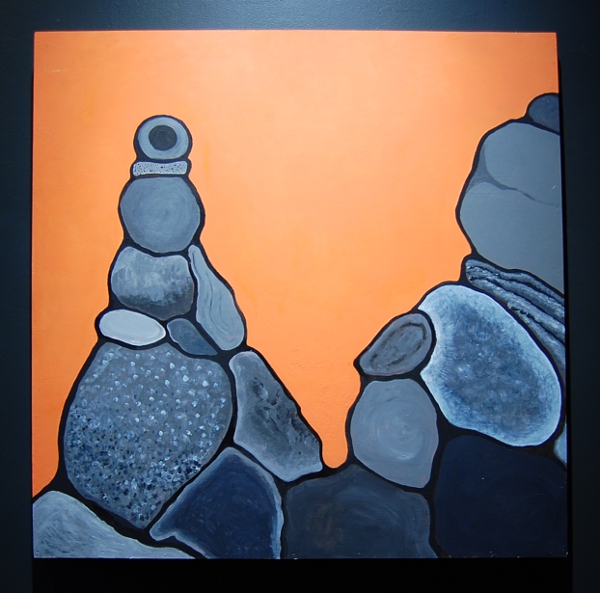
Walter Dunnington’s “Rocks”
Some of the most vibrant geology in Philadelphia can right now be found at the Crane Arts Building. In the Archive Space, Walter Dunnington takes a closer look at the stuff the earth is made of with his many views of stones and sediment.
Dunnington’s canvases take on many forms, just like the earth beneath us. Some paintings feature piles of gray chunks while others focus on the subterranean with cross-sections of the ground and the hidden gems within. Indeed, this artist takes so many liberties with his representations that he seemingly portrays every type of rock but Led Zeppelin.
Walter Dunnington, “River.”
Some images are relatively realistic – white stones hidden beneath healthy, brown soil. Others appear to float, ungrounded, in bright color fields like washes of yellow, orange or violet. The spaces between the positive structures lie filled with material too, lending their appearance to the mortared surfaces of stone walls or tiled walkways.
Walter Dunnington, “Rocks II”, “Rocks I” and “Rocks.”
The artist liberally applies acrylic paint in blocks of solid color, creating fairly minimal constructions, considering the potential complexity with which he might otherwise embrace. After all, the earth we share is wildly diverse and chock full of many compositions of elements. Instead, he reduces the underground to abstractions, which sometimes even pull away from his overall theme.
Walter Dunnington, “Eyes.”
While most of the compositions are quite clearly crags of cold slabs, some of them deviate even further. Many of his pieces verge on the microscopic worlds which share and intermingle within the ground such as bacteria. A few works include centrally located structures which look more like cell nuclei than geological forms. One painting even flows with liquid-like streams of round, open shapes that most closely resemble bubbles than anything else.
Complex close-ups of sand grains, surveys of local biology, mountains or molehills, Walter Dunnington displays the earth in a fun, colorful way that only nods to reality. He expands the definitions of the earth, and examines both what is and what could be. The earth is surely a majestic place, but it would appear that Dunnington’s rose-colored glasses make everything a tinge brighter and simpler. The exhibit will be on display through March 12.
The Crane Arts Building is located at 1400 N. American St., Philadelphia; [email protected]; cranearts.com.
Recent Content
-
Artsarticle ·
-
Artsarticle ·
-
Artsarticle ·




